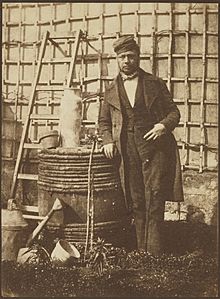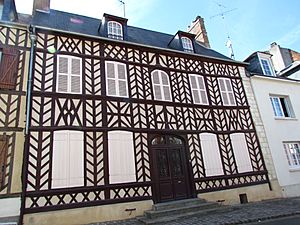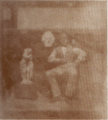Hippolyte Bayard facts for kids
Hippolyte Bayard (born January 20, 1801 – died May 14, 1887) was a French photographer. He was a true pioneer in the early days of photography. He invented his own special way to make photos directly on paper. He even held the world's first public photo exhibition on June 24, 1839!
Bayard believed he invented photography before others often given credit, like Louis-Jacques Mandé Daguerre in France and William Henry Fox Talbot in England. He experimented a lot with this new art. He took pictures of plants, statues, and even himself posing with them. He also photographed busy street scenes, city views, buildings, and people, from famous figures to everyday workers. Bayard also helped start a photography society.
Contents
Bayard's Early Photography Work
While working for the government, Hippolyte Bayard spent his time experimenting with photography. He created his own unique method for making pictures. He called it the "direct positive process."
Here is how his process worked: First, he would make paper turn completely black by exposing it to light. Then, he would soak this paper in a special liquid. After that, he would put the paper into a camera. Once the picture was taken, he would wash the paper in another liquid and let it dry.
The photo he got was one-of-a-kind. You couldn't make copies of it. Because the paper wasn't very sensitive to light, it took about twelve minutes to take a picture. This meant that still objects, like flowers or bowls of fruit, were easier to photograph. If he took pictures of people, they had to keep their eyes closed. This was because blinking or moving their eyes during such a long exposure would make them look strange or "dead" in the photo.
In 1851, Bayard joined other photographers on a trip across France. They were asked to photograph old buildings and monuments. This was part of a project to document and save France's history.
The "Drowned Man" Photo
Hippolyte Bayard was asked to wait before telling the world about his photography process. This request came from François Arago, a friend of Louis Daguerre. Daguerre had invented a different photography method called the daguerreotype. Because of this delay, Bayard didn't get the credit he deserved as one of the main inventors of photography.
Bayard eventually shared the details of his process in February 1840. He received some money to buy better equipment. But he felt very unfairly treated. So, to show how he felt, Bayard created a very famous picture. It was a staged photograph called Self Portrait as a Drowned Man. In this photo, he pretended to have died, sitting and leaning to the side. On the back of this powerful photo, Bayard wrote a message about the injustice he felt.
Later Photography Career
Even though he faced challenges early on, Bayard continued to be an important part of the photography world. He helped start the French Society of Photography. This was a group for photographers.
Bayard was also one of the first photographers hired to document and save historical buildings in France. This project was called the Missions Héliographiques in 1851. He used a paper photography process, similar to his own invention, for this work. He also had a clever idea called combination printing. This meant taking two different pictures and putting them together. For example, he would take one picture for the sky and another for the land or building. This helped make sure both parts of the photo looked good. This idea became popular in the 1850s.
Famous Photographs by Bayard
- Self Portrait as a Drowned Man, 1840.
- Specimens, 1842.
- Construction Worker, Paris, 1845–1847.
- Self Portrait in the Garden, 1847.
Images for kids
See also
 In Spanish: Hippolythe Bayard para niños
In Spanish: Hippolythe Bayard para niños
- Bayard Islands

















